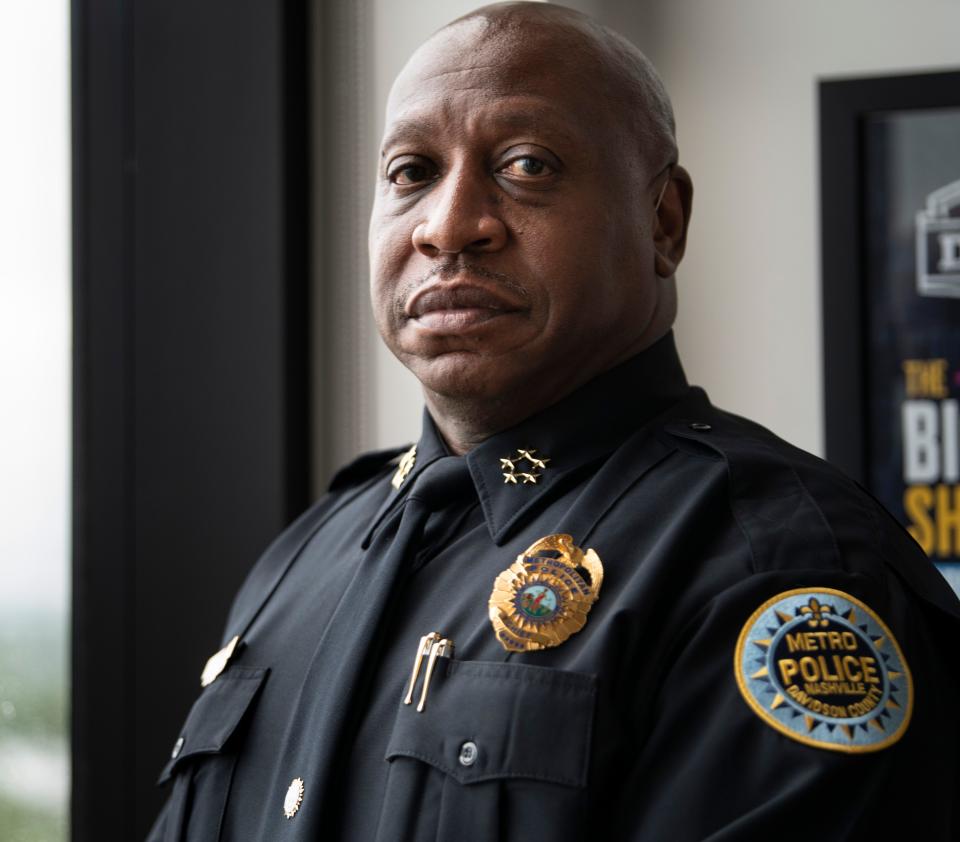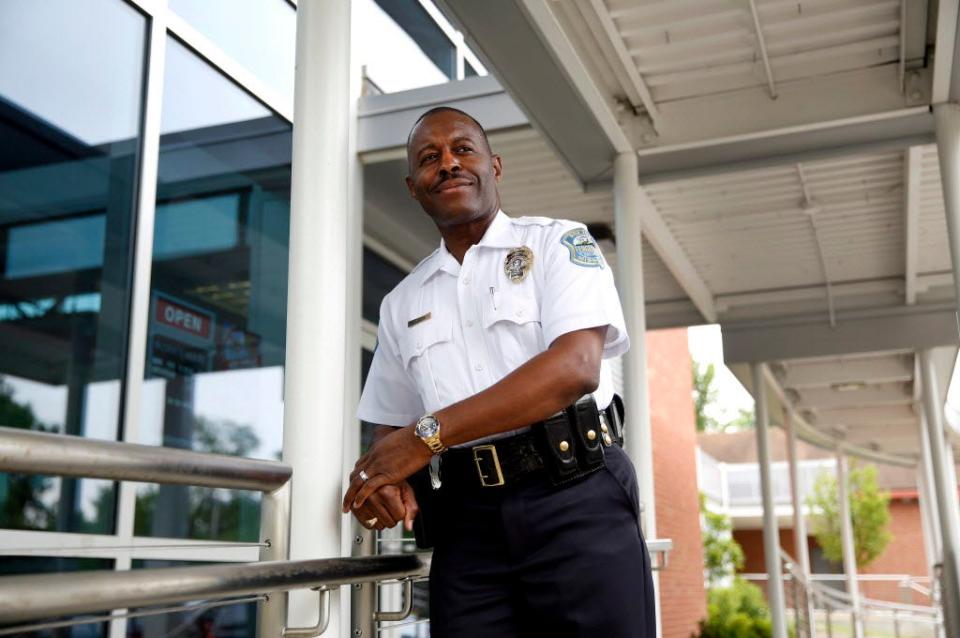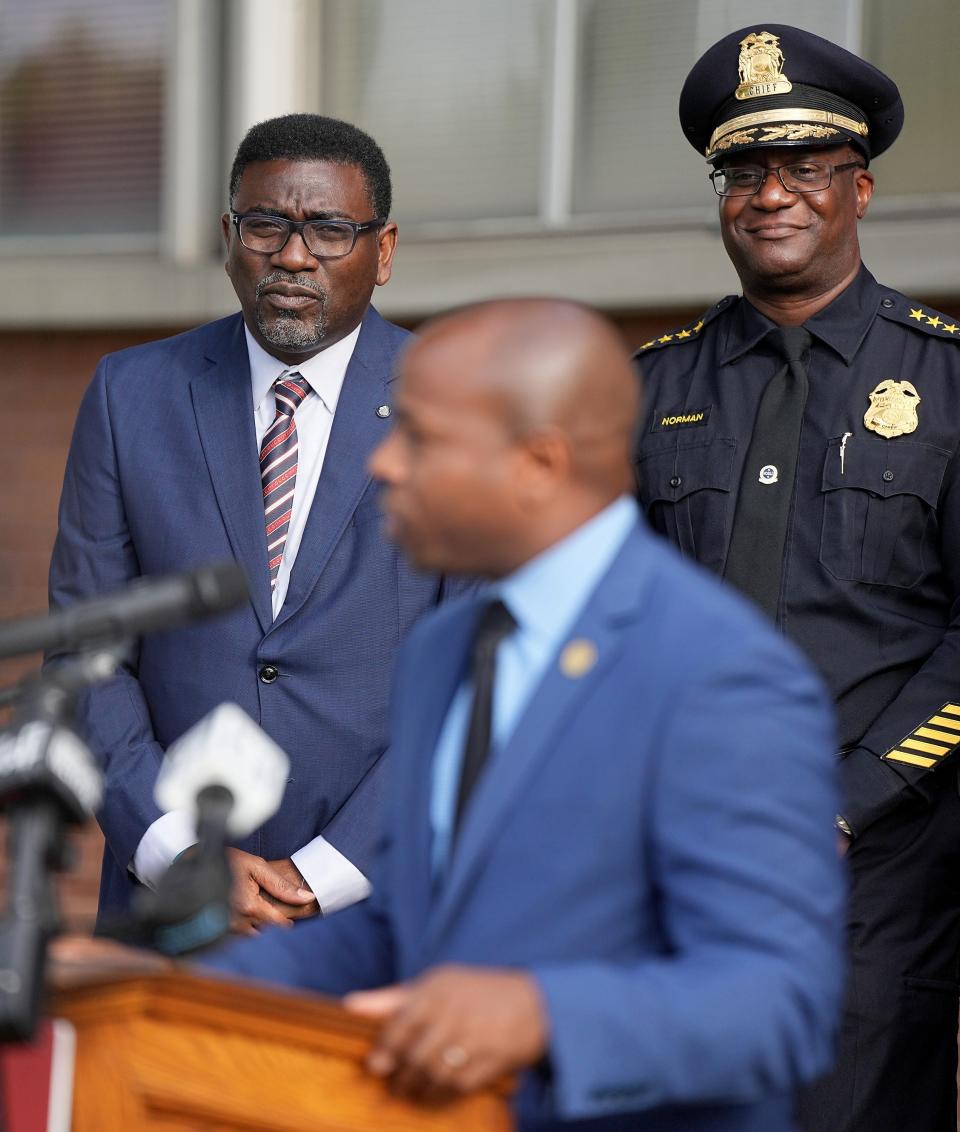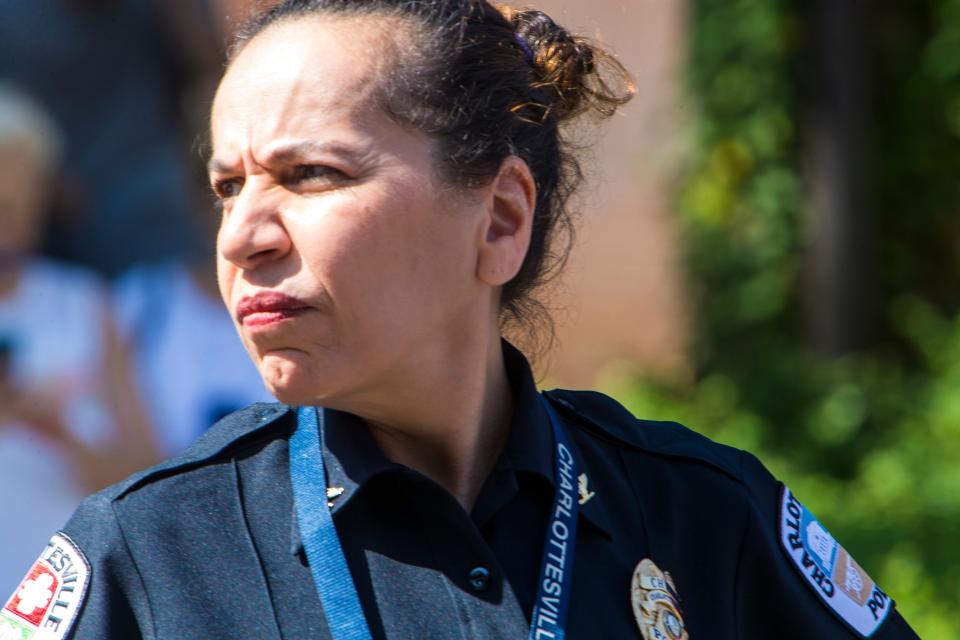Black chiefs pushing police reform face racism, anger from officers and their communities
John Drake remembers disliking the police during his youth in Nashville, Tennessee. One of his earliest interactions with the Metropolitan Nashville Police Department was being falsely accused of the brutal rape of an 89-year-old woman, despite bearing little resemblance to the description of the assailant.
Drake is now chief of that same police department. And his story is similar to those of other Black police leaders.
Daniel Hahn, former police chief in Sacramento, California, grew up in the city’s impoverished Oak Park neighborhood and was arrested at 16 years old. He said he was arrested for assaulting an officer. He didn’t hate police, he said, but when he was in college, he brushed off police recruiters multiple times.

Boston Police Commissioner Michael Cox said becoming a police officer had never seemed a possibility to him because there were so few people of color in the department. In 1995, a few years after he joined the force in Boston, Cox was beaten by fellow officers who mistook him for a suspect, an incident that was covered up until Cox won more than $1 million in a civil rights lawsuit.
Despite such negative encounters, all three men persevered to lead law enforcement in their hometowns.
“My upbringing prepared me for all of it,” Hahn said. “It gave me perspective and gave me compassion. I’m in both worlds, and so I can understand fully.”
Drake and Cox agree that their racial identity informs their work as they take on the challenge of repairing police relationships with communities of color. Still, many Black police chiefs say they face intense pushback from their own officers as they press for reform, and they often see anger directed at them from citizens scarred by a history of mistreatment at the hands of police – tensions again inflamed by the murder of George Floyd by police officers in Minneapolis in 2020 and subsequent nationwide protests for social justice.
“I was supposed to solve all the world’s issues, at least the Black issues, with the snap of my finger,” said Hahn, who led the Sacramento department during the protests over the killing of Stephon Clark by police in that city in 2018. “I’d be called a coon, a sellout, Uncle Tom by the Black community. I’d be discriminated against in many different ways by non-Black communities.”
When the officers are Black: Tyre Nichols' death raises tough questions about race in policing

Diversity in itself is ‘not enough’
Policing is an overwhelmingly white profession, and reform advocates have been calling for police departments to increase diversity for decades.
In 2020, the Bureau of Justice Statistics at the Department of Justice reported that just 6% of chiefs of local police departments were Black, though chiefs were much more likely to be Black in departments serving 250,000 or more residents.
For Black Americans in traffic stops: 'We carry the burden of ensuring we are not murdered'
Increasing diversity in police leadership can have a positive influence on police culture and policies, but it is not enough to solve the deeper issues in police culture, said Jacinta Gau, professor of criminal justice at the University of Central Florida.
“We need diversity of all sorts, but we need it particularly in those higher ranks,” Gau said. “It is not enough to have a Black chief.”
As with Hahn in Sacramento – where the unarmed Clark was killed in his grandmother’s backyard – having a person of color at the helm does not insulate a department from national scrutiny over a police killing or systemic misconduct.
When 29-year-old Tyre Nichols was fatally beaten after a traffic stop last month, Memphis police were led by the first Black female police chief, Cerelyn "CJ" Davis.
Davis was initially praised for swiftly firing five officers who were later charged with murder, but she has since faced criticism for creating the violent crime unit in which the five officers worked. The team, called the SCORPION unit, has been compared to similar controversial units in other cities and has since been disbanded. Davis was not available for an interview for this story.
Still, many cities have hired Black chiefs, often for the first time, after facing backlash for similar incidents of police misconduct.
'You've got to have a diverse police department': Police diversity lags in many cities
In 1992, Willie L. Williams became the first Black chief of the Los Angeles Police Department after video of officers beating a Black man, Rodney King, gained worldwide attention. The officers’ acquittal on criminal charges led to widespread riots.
In 2016, Delrish Moss was sworn in as the first Black chief in Ferguson, Missouri, a suburb of St. Louis. Ferguson was the subject of a scathing Justice Department report that raised concerns about the majority Black community’s overwhelmingly white police force after the shooting death of Michael Brown, 18, in 2014.

In 2020, Yvette Gentry was named interim chief in Louisville, Kentucky, becoming the first Black woman to lead the Louisville Metro Police amid backlash over the shootings of Breonna Taylor, 26, who was killed in her home by police, and David McAtee, 53, a restaurant owner killed by National Guard troops during protests that followed.
Despite some gains, many Black chiefs, including Carmen Best in Seattle and U. Reneé Hall in Dallas, stepped down amid public criticism of their handling of protests in 2020.
“It is lonely,” said Amal Awad, the first woman, first person of color and first known member of the LGBTQ community to lead the Anne Arundel County Police Department in the Annapolis, Maryland, area. “There’s a lot of pressure there, and I’m just me. I’m not Superwoman.”
Black police chiefs met with racism, anger
In addition to microaggressions and overt racism, new chiefs of color can face intense pressure from communities of color to make significant changes quickly, Gau said.
“They occupy the intersection of two groups that have historically had bad relations,” she said. “The police chief is a powerful position, but it’s only one person. Putting that level of pressure, putting that whole bag of expectations onto this one person, is kind of unfair and unrealistic.”
Cox said he questioned whether he wanted to continue being a Boston police officer during the height of the racial justice protests. “There was so much rhetoric around poor policing and how bad the police are and how much damage they’ve done in the world that I was even questioning, ‘Why am I in this profession?’”
Ultimately, he said, it motivated him to continue working with the community.

After Madison, Wisconsin, endured 180 days of demonstrations after Floyd’s death, Shon Barnes was sworn in as chief in February 2021. His first week on the job, he received an email addressing him using a racist slur.
As he spent weeks getting to know the community, Barnes said, he was often the target of anger and frustration, though he believes his background ultimately helped to calm tensions during the protests.
“I met with members of the community and had them literally scream at me about the history of police,” he said.
Barnes said some members of his department criticized him for spending so much time with residents, but he felt it was crucial to building trust.
“It is tough being a chief in this time, and it is doubly tough doing it as a Black man,” he said. “They don’t understand the amount of implicit bias that goes on in this position where people are questioning your expertise.”
Black police chiefs face internal pushback
Gau said Black police chiefs looking to make even symbolic changes often face opposition within their departments.
Jeffrey Norman, who was sworn in as chief in Milwaukee in November 2021 after nearly a year as acting chief, said he faced backlash when he restricted the use of “Thin Blue Line” imagery.

Norman said curtailing the use of the symbol, which was displayed by white supremacists and neo-Nazis during a deadly 2018 rally in Charlottesville, Virginia, was his way of taking a stand for equity and inclusion. “I got a lot of pushback on that,” he said. “There was a lot of frustration that was thrown to me.”
Before becoming chief of police and emergency management for Denver’s public transit system, Joel Fitzgerald was police chief in Waterloo, Iowa. He faced pushback when he suggested the Waterloo Police Department change its insignia – a green-eyed, red-bodied griffin, which some in the Black community say too closely resembles a Ku Klux Klan grand dragon.
Opponents not only framed the effort as an attack on officers but also criticized his personal life, such as his wife deciding not to move to the city. The city council later voted to remove the symbol from police uniforms, one of many changes Fitzgerald said he is proud of.
“I’ve had those battles … just because of who I am and what I look like,” said Fitzgerald, who was the first Black police chief in three other jurisdictions before Waterloo and Denver. “My hope is that more chiefs of color share their experiences and share the obstacles that they faced to get things done.”
Trying to make more substantial changes – like firing an officer for misconduct or addressing racial bias – can bring even greater internal opposition.
“Getting officer buy-in can be a big challenge … particularly, white officers are very likely to get defensive,” Gau said. “You’re up against policy, you’re up against the union, you’re up against any lawsuit that the officer might file if they are terminated.”
In 2018, when RaShall Brackney became the first Black woman to lead the police department in Charlottesville, Virginia, she was tasked with bringing legitimacy and transparency to an agency that had lost the community’s trust after the white supremacist rally.
She said she spent months meeting with residents, conducting an extensive review of the department’s policies and practices, and bringing in groups like the Anti-Defamation League to train officers.
Brackney said some officers were “extremely vocal” opponents to the changes, and the backlash intensified when she fired popular officers and disbanded specialty units, including the SWAT team, after uncovering thousands of inappropriate videos and text messages threatening her and making racist remarks.

“It was extremely unsettling,” she said. “I literally at that point start walking out of my police station with my weapons readily available and in my hand in case I have to respond to a threat from my own officers or officers that I’d terminated.”
Brackney was fired in September 2021. She said she filed complaints with multiple agencies, including the Equal Employment Opportunity Commission, before filing a $10 million lawsuit against the city and several current and former officials. Her lawsuit in June 2022 claims she was terminated because of race and gender discrimination. A federal judge dismissed her suit in January because there wasn't sufficient evidence of discrimination, conspiracy or malice.
Brackney said it’s unlikely she’ll be welcomed back into policing after her firing in Charlottesville. She said she worries about how many leaders like her have been pushed out of the profession.
“We need to create opportunities and off ramps for individuals to be successful in going about the work differently. And maybe chief is not the space to be in. And maybe it’s in education. And maybe run for office,” she said.
“Maybe we all have to think about giving up some of our policing powers and give those back to the community.”
Contributing: The Associated Press
This article originally appeared on USA TODAY: How Black chiefs pushing police reform face pressure from both sides

 Yahoo Movies
Yahoo Movies 
